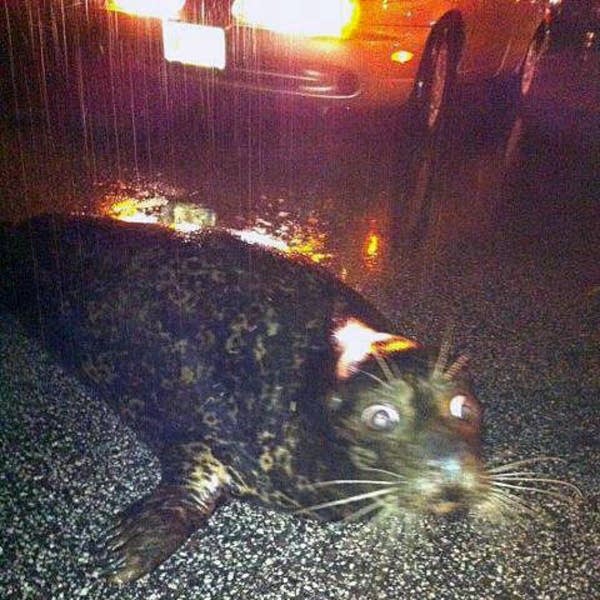Q&A: Lake Superior Zoo sustains damage in flood

Susan Wolniakowski, the Lake Superior Zoo's director of guest services, spoke with MPR's Cathy Wurzer about flooding at the zoo on Wednesday.
Cathy Wurzer: I can't tell you how many listeners have been emailing me and calling. They're concerned about the zoo. Give us an update. What's going on?
Susan Wolniakowski: I'm glad that everybody's concerned for us. It's been a pretty tough night and a pretty tough morning here, to be honest with you. We've had major flooding from the Kingsbury Creek that runs through our zoo grounds.
It has encompassed several of our exhibits, including our Polar Shores area. We did have two seals escape this morning, Vivienne and Feisty. They were relatively easily corralled and they are secure and they are safe and they are in their holding (area) again.
Create a More Connected Minnesota
MPR News is your trusted resource for the news you need. With your support, MPR News brings accessible, courageous journalism and authentic conversation to everyone - free of paywalls and barriers. Your gift makes a difference.
I know for a while there were rumors that the polar bear was out and wandering Duluth. That was not the case. Berlin did get out of her exhibit. She did not get very far before the zookeepers found her and she was able to be tranquilized and she is also safe and secure and in her holding area.
Wurzer: By the way, where were the seals found?
Wolniakowski: One of them was found on Grand Avenue actually, and that was our first clue that the zoo was flooding actually, was somebody had reported her on Grand Avenue, and they had called our director of animal management.
And he had come out to the zoo and realized of course that if she was out of her exhibit, it probably meant that there were other animals that were out of their exhibits as well, and that's when we realized what the situation was. And that was at about 3:30 this morning, I think.
Wurzer: There were concerns other animals escaped, but everyone's accounted for, is that correct?
Wolniakowski: At this time, not quite everybody is accounted for. All our carnivores are secure and accounted for. Our Polar Shores animals, except for our snowy owl, are safe and secure and accounted for. Our barnyard also got flooded, so there are some of those animals that are still unaccounted for. We did experience some animal loss in our barnyard.
There are also some exhibits that we just can't get to at this time because of the flooding. I get periodic reports up here in the office as the zoo keepers are trying to access other exhibits out there on the zoo grounds and make sure everybody's safe.
The water's pretty high, and the rain is still coming down, so they're trying to keep an eye on things and until the water does go down, there are going to be some areas that we just aren't going to be able to get to.
Wurzer: Do you know how many animals died in the barnyard exhibit?
Wolniakowski: I don't have any figures on that. We had a lot of goats and sheep in there. I know that our horse, Darla, which a lot of people are familiar with, she was found safe and secure, but I don't have any other details on the barnyard animals.
Wurzer: The Duluth zoo, as you know, Susan, is an old zoo. It was built by some of the WPA workers back in the day, and you have some lovely buildings. Has there been much damage sustained, do you know, at this point?
Wolniakowski: Again, it's pretty difficult to tell. A lot of the WPA bridges, those are all underwater right now. And in fact, we had just done some maintenance on those bridges, so we're really hoping that they're going to fare pretty well. They're pretty solidly built, which is nice, but it's pretty hard to tell at this point in time.
I know that there has been some damage to our Polar Shores building, our structure down there. So I think until the water recedes, we're not going to know extent of the damage.
Wurzer: For people who've not been to the Duluth zoo, you're kind of in a little bit of a valley. Are you flood prone anyway?
Wolniakowski: We haven't been in the past ... We are in a valley, and that's kind of a bonus because it is a beautiful creek, Kingsbury Creek, that runs through the middle of the zoo grounds. It's all natural and it's a trout stream. As beautiful as it is, this is just the second time I believe that the zoo has flooded. The first time was because a culvert collapsed, and we have a suspicion that that's the same case this time as well. So, that just kind of causes all the water from the creek to back up from the zoo.
Wurzer: As we sit here on the phone together, Susan, as you look out a window, can you describe what you see?
Wolniakowski: It's kind of sad. I've been stuck here in the office answering phones, and I really haven't had a chance to see a lot of the zoo grounds, but it's kind of strange when you do look off the tiger deck, you do see just brown water that extends quite a distance up our animal care center hill, and if people are familiar with that, they know it's a pretty high hill, one of the highest points in the zoo. And you can definitely see the water line, how high it was this past evening, and it was pretty high.
